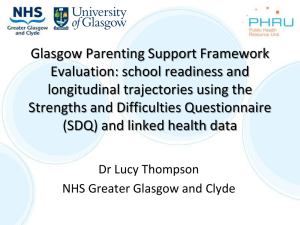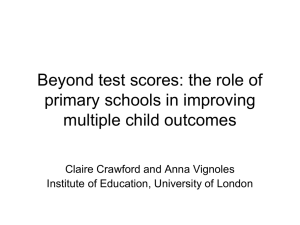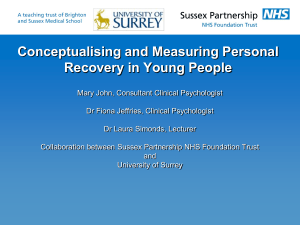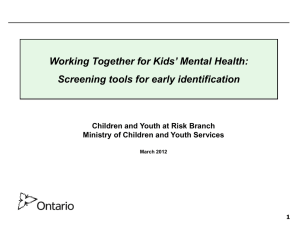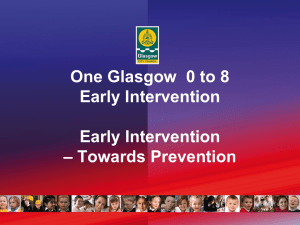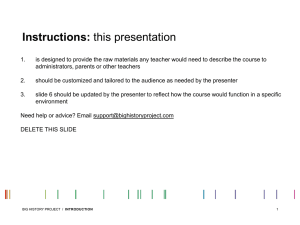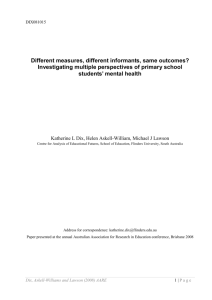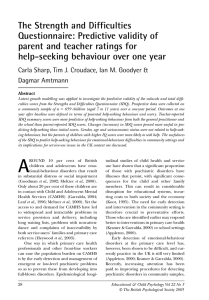SDQ Slides - Australian Mental Health Outcomes and Classification
advertisement
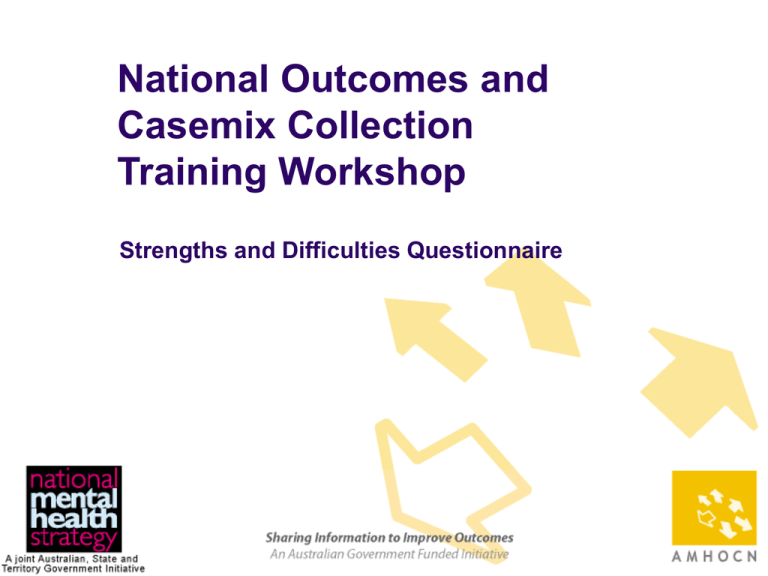
National Outcomes and Casemix Collection Training Workshop Strengths and Difficulties Questionnaire 1 Learning Objectives At the completion of this session participants will be able to: Describe the SDQ and its various versions Identify the components of the various versions of the SDQ Describe the scoring of the SDQ Describe approaches to interpretation of the SDQ 2 What is the Strengths and Difficulties Questionnaire (SDQ) Developed by Dr Robert Goodman, Institute of Psychiatry, Kings College, University of London. Designed as a brief behavioural screening questionnaire about 4 -17 year olds Exists in several versions to meet the needs of researchers, clinicians and educationalists. Each version includes between three or four of the following components: A) 25 items on psychological attributes. B) An impact supplement C) Cross informant information D) Follow-up questions Note:four ‘teacher’ versions are available, these are not required for the National Outcomes and Casemix Collection. 3 Versions of the SDQ There are six versions (parent-report and young persons self report) currently specified under the National Outcomes and Casemix Collection PC1 – Parent Report Measure for Children aged 04-10, Baseline version; PC2 – Parent Report Measure for Children and Adolescents aged 410, Follow up version PY1 – Parent Report Measure for Youth aged 11-17, Baseline version; PY2 – Parent Report Measure for Youth aged 11-17; Follow up version YR1 – Youth self report measure (11-17), Baseline version YR2 – Youth self report measure (11-17), Follow up version. The different versions have different rating periods and different combinations of components. 4 Versions of the SDQ Items 1-25 Informant Parent Age range Application Rating period 4-10 Symptoms Overall 27 Duration 28-33 Impact 34-35 Follow up progress 36-38 Cross-Informant information Cross-Informant information 11-17 11-17 Baseline Followup Baseline Follow-up Baseline Followup 6 months 1 month 6 months 1 month 6 months 1 month Version Item Content 26 39-42 Young Person PC1 PC2 PY1 PY2 YR1 YR2 x x x x x x x x x x x x x x x 5 Extended SDQ: 25 items on psychological attributes (Symptom Items) emotional symptoms (5 items) conduct problems (5 items) “Restless, overactive, cannot stay still for long “ peer relationship problems (5 items) “Often fights with other children “ hyperactivity/inattention (5 items) “Many worries or often seems worried “ “Rather solitary, prefers to play alone “ added together to generate a Total difficulties score (based on 20 items) prosocial behaviour (5 items) “Considerate of other people’s feelings “ Total Score 0 - 40 Note Some items are reversed Three point scale “not true”,, “somewhat true” or “certainly true” 6 Extended SDQ : Impact The SDQ includes items which identify the impact of the psychological attributes of the child or adolescent. A probe question is asked “Overall, do you think that your child has difficulties in any of the following areas: emotions, concentration, behaviour or being able to get along with other people”? If the answer to this probe is “No”, the impact questions are not asked. Respondents indicate there have been problems they are then asked to rate chronicity, distress, social impairment, and burden to others. This is useful additional information for clinicians and researchers re psychiatric caseness and the determinants of service use 7 Extended SDQ : Cross Informant On admission, respondents are asked to identify teachers impressions of the child or young persons presentation. “Over the last six months, have your child’s teachers complained of…’ E.g. “Acting without thinking, frequently butting in, or not waiting for his or her turn” These cross informant questions provide useful additional clinical information giving a sense of how pervasive any difficulties may be In addition single informant SDQ (Parent or Child/Young Persons) provide useful information which can give a rough probability of diagnosis. However in the case of Hyperkinetic disorder, overactivity is most evident in structured situations such as school, this requires information from informants such as teachers. 8 Extended SDQ : Follow-up Two additional questions are asked to determine follow up progress “Has the intervention reduced problems”? “Has the intervention helped in other ways, eg. making the problems more bearable”? Note: To increase the chance of detecting change, the follow-up versions of the SDQ ask about 'the last month', as opposed to 'the last six months‘ The Chronicity Questions are absent from the follow-up version 9 Special Considerations Generally, the ‘admission’ versions are administered on admission and rated over the standard rating period of six months and the ‘follow up’ versions are administered on review and discharge and rated over a one month period. However, for referral from another setting, to prevent duplication and undue burden on consumers and parents, the following guide is suggested: 10 Special Considerations Transfer of care between an inpatient, community residential or ambulatory setting of a consumer currently under the active care of the Mental Health Service Organisation. Admission SDQ - if Follow Up SDQ required at the end of referring treatment settings episode is neither completed nor provided by referring setting. Admission to a new inpatient, community residential or ambulatory episode of care for any reason other than defined above. Admission SDQ - if Follow Up SDQ required at the end of referring treatment settings episode is neither completed nor provided by referring setting. Follow Up SDQ - if Follow Up SDQ is required at end of referring treatment settings episode has in fact been completed and provided by the referring setting. Follow Up SDQ - if Follow Up SDQ required at end of referring treatment settings episode has not been completed or is not provided by the referring setting. 11 Consumer Self Report Measure: When NOT to Offer The consumer is too unwell or distressed to complete the measure The consumer is unable to understand the measure Psychotic or mood disturbance prevents the consumer from understanding the measure or alternatively, completing the measure would increase their level of distress As a result of an organic mental disorder or a developmental disability to consumer Cultural or language issues make the self-report measure inappropriate 12 Offering the Measure Why is it important to complete a consumer and carer self rated measure? What happens if the carer or consumer refuses to complete the measure, will it effect their treatment? Who is going to use the information? What is the information going to be used for? Assure the consumer of privacy and confidentiality. 13 Scoring the SDQ Total Difficulty Score 0 (Not True), 1 (Somewhat True), 2 (Certainly True) For each of the 5 scales the scores can range from 0-10 if all 5 items were completed Note some items reversed (7, 11, 14, 21 and 25) Total Score = Emotional Scale + Conduct Scale + Hyperactivity Scale + Peer Problem Scale. Impact Score Items 28 through 32 are added together to derive the impact score. Note coding: Not at all (0) A little (0) A medium amount (1) A great deal (2) Cross Informants Although these items are clinically useful, they are not scored but become available for further NOCC development 14 Interpreting the SDQ 'This score is close to average - clinically significant problems in this area are unlikely' 'This score is slightly raised, which may reflect clinically significant problems' 'This score is high - there is a substantial risk of clinically significant problems in this area' 0-13 14-16 17-40 Emotional Symptoms Score 0-3 4 5-10 Conduct Problem Score 0-2 3 4-10 Hyperactivity Score 0-5 6 7-10 Peer Problem Score 0-2 3 4-10 'This score is close to average – clinically significant problems in this area are unlikely' 'This score is slightly low, which may reflect clinically significant problems' 'This score is low - there is a substantial risk of clinically significant problems in this area' Prosocial Behaviour Score 6-10 5 0-4 SELF COMPLETED VERSIONS 'This score is close to average - clinically significant problems in this area are unlikely' 'This score is slightly raised, which may reflect clinically significant problems' 'This score is high - there is a substantial risk of clinically significant problems in this area' 0-15 16-19 20-40 Emotional Symptoms Score 0-5 6 7-10 Conduct Problem Score 0-3 4 5-10 Hyperactivity Score 0-5 6 7-10 Peer Problem Score 0-3 4-5 6-10 'This score is close to average - clinically significant problems in this area are unlikely' 'This score is slightly low, which may reflect clinically significant problems' 'This score is low - there is a substantial risk of clinically significant problems in this area' 6-10 5 0-4 PARENT VERSIONS Total Difficulties Score Total Difficulties Score Prosocial Behaviour Score 15 Strengths and Difficulties Questionnaire More Information available at www.mhnocc.org www.sdqinfo.com “Sharing Information to Improve Outcomes” An Australian Government funded initiative 16
